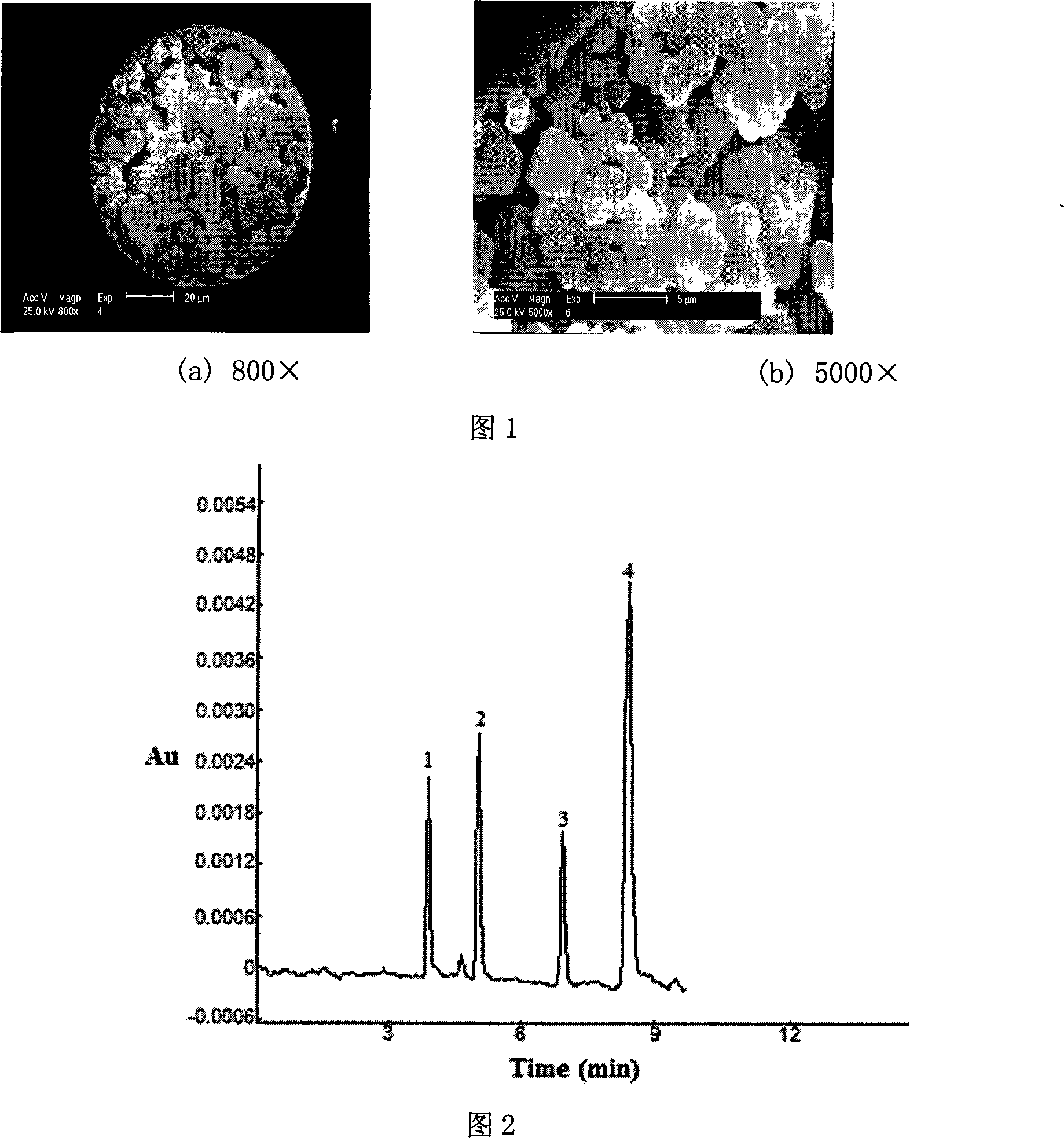Raw material prescription of polar ion interchange electric chromatographic column and preparation thereof
A technology of ion exchange and electrochromatographic column, which is applied in the field of raw material formulation and preparation of polar ion exchange electrochromatographic column, which can solve problems such as interruption of electroosmotic flow, generation of bubbles at the interface, and test failure, so as to achieve good permeability and avoid irreversibility The effect of tailing and a wide range of pH application
- Summary
- Abstract
- Description
- Claims
- Application Information
AI Technical Summary
Problems solved by technology
Method used
Image
Examples
Embodiment 1
[0019] 1. Pretreatment of capillaries
[0020] First wash the empty capillary column with 0.1mol / L HCl solution for about 30min, then rinse with deionized water for 15min, then rinse with 0.1mol / L NaOH for 4h, then rinse with deionized water for 15min, then rinse with methanol for 15min, Blow dry with nitrogen gas.
[0021] 2. Add a mixture of methanol and methacryloxypropyltrimethoxysilane with a volume ratio of 1:1 to the capillary treated in step 1, and react at 60° C. for 24 hours. Then rinse with methanol for 15min. Blow dry at 70°C with nitrogen.
[0022] 3. In-column synthesis
[0023] 2-hydroxyethyl methacrylate, ethylene glycol dimethacrylate, methacrylic acid, toluene and lauryl alcohol were respectively 23.9%, 8.0%, 8.0%, 29.9%, 30.1% by weight, added The amount of initiator azobisisobutyronitrile (AIBN) is 0.3% of the amount of polymer monomer. After the mixture is ultrasonically oscillated for 15 minutes, nitrogen gas is blown for 10 minutes to remove dissolve...
Embodiment 2
[0025] 2-hydroxyethyl methacrylate, ethylene glycol dimethacrylate, N, N-allyl dimethylamine, cyclohexanol and dodecanol were respectively 28.0%, 8.1%, 4.0%, 29.8%, 30.1%, the amount of the added initiator azobisisobutyronitrile is 1% of the amount of the polymer monomer, after the mixture is ultrasonically oscillated for 15 minutes, nitrogen is blown for 10 minutes to remove dissolved oxygen, and the reaction solution is injected into In the treated capillary of a certain length, seal both ends of the capillary, and react for 20 hours under a UV lamp at 25°C. After the reaction is completed, wash the column with methanol and then with mobile phase to remove possible residual reagents in the capillary. , to obtain a polar ion-exchange electrochromatographic column.
Embodiment 3
[0027] 2-hydroxyethyl methacrylate, ethylene glycol dimethacrylate, methacrylic acid, toluene and lauryl alcohol were respectively 23.9%, 8.0%, 8.0%, 25.8%, 35.2% by weight, added The amount of initiator azobisisobutyronitrile is 0.3% of the amount of polymer monomers. After the mixture is ultrasonically oscillated for 20 minutes, nitrogen gas is blown for 10 minutes to remove dissolved oxygen, and the reaction solution is injected into a treated capillary of a certain length. In the process, both ends of the capillary were sealed, immersed in a water bath at 60°C, and reacted for 10 hours. After the reaction was completed, the column was first washed with methanol and then with mobile phase to remove possible residual reagents in the capillary, and polar ion exchange electrochromatography was obtained. column.
PUM
 Login to View More
Login to View More Abstract
Description
Claims
Application Information
 Login to View More
Login to View More - R&D
- Intellectual Property
- Life Sciences
- Materials
- Tech Scout
- Unparalleled Data Quality
- Higher Quality Content
- 60% Fewer Hallucinations
Browse by: Latest US Patents, China's latest patents, Technical Efficacy Thesaurus, Application Domain, Technology Topic, Popular Technical Reports.
© 2025 PatSnap. All rights reserved.Legal|Privacy policy|Modern Slavery Act Transparency Statement|Sitemap|About US| Contact US: help@patsnap.com

